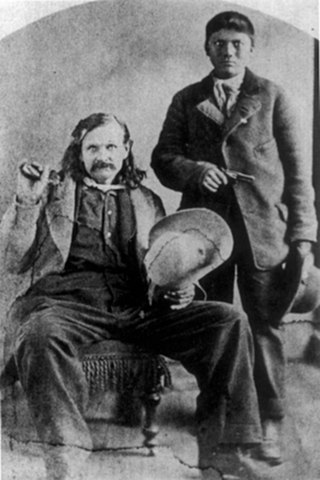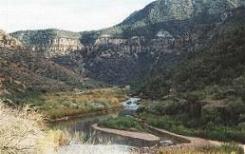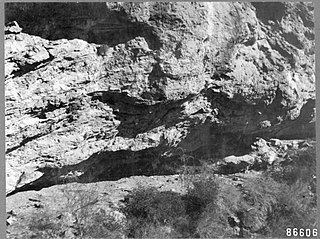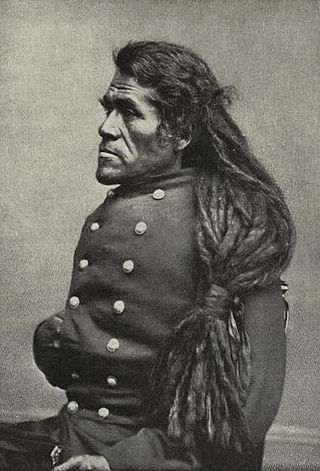
Wickenburg is a town in Maricopa and Yavapai counties, Arizona, United States. The population was 7,474 at the 2020 census, and was estimated to be 7,920 in 2022.

Olive Ann Oatman was a White American woman celebrated in her time for her slavery and later release by Native Americans in the Mojave Desert region when she was a teenager. She later lectured about her experiences.

Mary Ann Oatman was the sister of Olive Oatman. She is notable for surviving a gruesome attack on her family, “the Oatman Massacre” by south-western Native Americans who, according to historian Brian McGinty, were likely Tolkepaya, of the Yavapai, in what is now Arizona. Mary Ann and her sister Olive were both abducted. Following their abduction, the sisters were traded to the Mojave tribe. The date of her death is uncertain. According to Olive Oatman, Mary Ann died of starvation as a result of a severe drought.

The Western Apache are a subgroup of the Apache Native American people, who live primarily in east central Arizona, in the United States and north of Mexico in the states of Sonora and Chihuahua. Most live within reservations. The Fort Apache Indian Reservation, San Carlos Apache Indian Reservation, Yavapai-Apache Nation, Tonto Apache, and the Fort McDowell Yavapai Nation are home to the majority of Western Apache and are the bases of their federally recognized tribes. In addition, there are numerous bands. The Western Apache bands call themselves Ndee (Indé). Because of dialectical differences, the Pinaleño/Pinal and Arivaipa/Aravaipa bands of the San Carlos Apache pronounce the word as Innee or Nnēē:.

John W. Swilling was an early pioneer in the Arizona Territory. He is commonly credited as one of the original founders of the city of Phoenix, Arizona. Swilling also played an important role in the opening of the central Arizona highlands to white settlement. His discoveries resulted in a gold rush to the region, and this in turn led to the establishment of Arizona's first territorial capital at the mining town of Prescott.

The Apache Wars were a series of armed conflicts between the United States Army and various Apache tribal confederations fought in the southwest between 1849 and 1886, though minor hostilities continued until as late as 1924. After the Mexican–American War in 1846, the United States annexed conflicted territory from Mexico which was the home of both settlers and Apache tribes. Conflicts continued as American settlers came into traditional Apache lands to raise livestock and crops and to mine minerals.

The Tonto Apache Tribe of Arizona or Tonto Apache is a federally recognized tribe of Western Apache people located in northwestern Gila County, Arizona. The term "Tonto" is also used for their dialect, one of the three dialects of the Western Apache language, a member of Southern Athabaskan language family. The Tonto Apache Reservation is the smallest land base reservation in the state of Arizona.

The Camp Grant massacre, on April 30, 1871, was an attack on Pinal and Aravaipa Apaches who surrendered to the United States Army at Camp Grant, Arizona, along the San Pedro River. The massacre led to a series of battles and campaigns fought between the Americans, the Apache, and their Yavapai allies, which continued into 1875, the most notable being General George Crook's Tonto Basin Campaign of 1872 and 1873.

The Apache Scouts were part of the United States Army Indian Scouts. Most of their service was during the Apache Wars, between 1849 and 1886, though the last scout retired in 1947. The Apache scouts were the eyes and ears of the United States military and sometimes the cultural translators for the various Apache bands and the Americans. Apache scouts also served in the Navajo War, the Yavapai War, the Mexican Border War and they saw stateside duty during World War II. There has been a great deal written about Apache scouts, both as part of United States Army reports from the field and more colorful accounts written after the events by non-Apaches in newspapers and books. Men such as Al Sieber and Tom Horn were sometimes the commanding officers of small groups of Apache Scouts. As was the custom in the United States military, scouts were generally enlisted with Anglo nicknames or single names. Many Apache Scouts received citations for bravery.

The Yavapai are a Native American tribe in Arizona. Their Yavapai language belongs to the Upland Yuman branch of the proposed Hokan language family.
The Little Arkansas Treaty was a set of treaties signed between the United States of America and the Kiowa, Comanche, Plains Apache, Southern Cheyenne, and Southern Arapaho at Little Arkansas River, Kansas in October 1865. On October 14 and 18, 1865 the United States and all of the major Plains Indians Tribes signed a treaty on the Little Arkansas River, which became known as the Little Arkansas Treaty. It is notable in that it lasted less than two years, the reservations it created for the Plains Indians were never created at all, and were reduced by 90% eighteen months later in the Medicine Lodge Treaty.

King S. Woolsey was an American pioneer rancher, prospector and politician in 19th century Arizona. Woolsey Peak and other features of Arizona geography have been named after him, but he has also been criticized by historians for brutality in his battles with Apache Native Americans.

The Battle of Salt River Canyon, the Battle of Skeleton Cave, or the Skeleton Cave Massacre was the first principal engagement during the 1872 Tonto Basin Campaign under the command of Lieutenant Colonel George Crook. It was part of the Yavapai War from 1871 to 1875 against the Yavapai people, a Native American tribe in Arizona.

Fort McDowell is an unincorporated community in Maricopa County, Arizona, United States. Fort McDowell is 23 miles northeast of Phoenix. Fort McDowell has a post office with ZIP code 85264.
The 5th Arizona Territorial Legislative Assembly was a session of the Arizona Territorial Legislature which met from November 10, 1868, to December 16, 1868, in Tucson, Arizona Territory. It was the last of the annual legislative sessions.
The 6th Arizona Territorial Legislative Assembly was a session of the Arizona Territorial Legislature which met in Tucson beginning on January 11, 1871, and ran until February 14, 1871.

The Yavapai Wars, or the Tonto Wars, were a series of armed conflicts between the Yavapai and Tonto tribes against the United States in the Arizona Territory. The period began no later than 1861, with the arrival of American settlers on Yavapai and Tonto land. At the time, the Yavapai were considered a band of the Western Apache people due to their close relationship with tribes such as the Tonto and Pinal. The war culminated with the Yavapai's removal from the Camp Verde Reservation to San Carlos on February 27, 1875, an event now known as Exodus Day.

John Tabor Alsap was an American physician, lawyer, politician, and farmer active in the early days of Arizona Territory. Among his accomplishments are being appointed the first Treasurer of Arizona Territory, being elected to four terms of the territorial legislature, serving as both Speaker of the House and President of the Council in the Arizona Territorial legislature, and becoming the first Mayor of Phoenix.

Irataba was a leader of the Mohave Nation, known as a mediator between the Mohave and the United States. He was born near the Colorado River in present-day Arizona. Irataba was a renowned orator and one of the first Mohave to speak English, a skill he used to develop relations with the United States.

Gillett, Arizona, is a ghost town in Yavapai County, Arizona, United States. It has an estimated elevation of 1,362 feet (415 m) above sea level. Historically, it was a stagecoach station, and then a settlement formed around an ore mill serving the Tip Top Mine, on the Agua Fria River in Yavapai County in what was then Arizona Territory. It was named for the mining developer of the Tip Top Mine, Dan B. Gillett and is spelled incorrectly as Gillette on U. S. Topographic Maps and elsewhere.


















